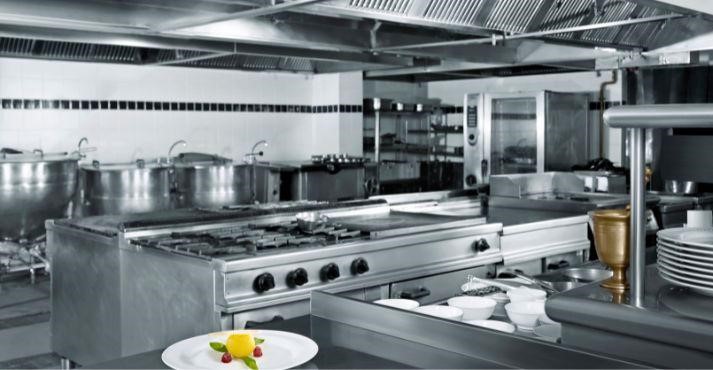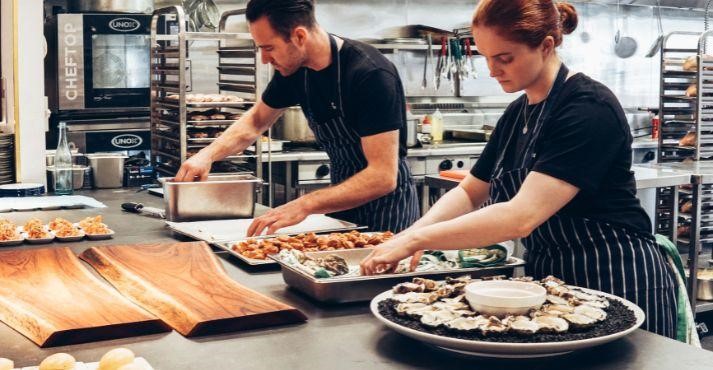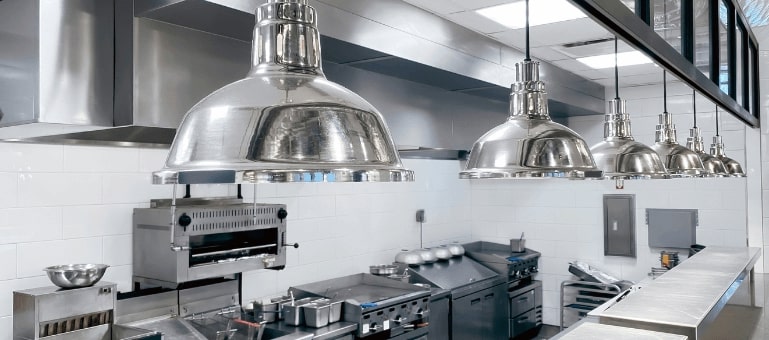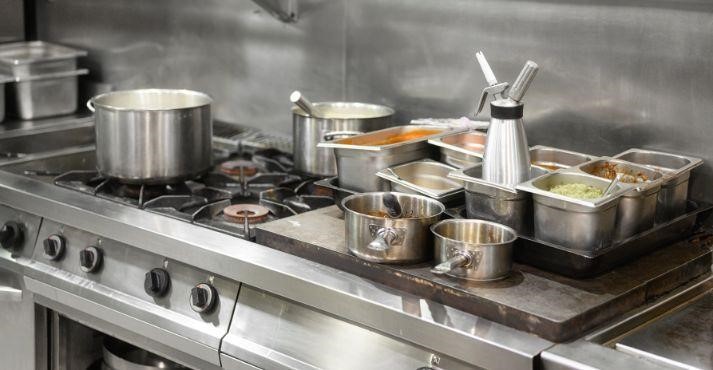A successful restaurant is only as good as its kitchen. But what is a commercial kitchen? Behind every delicious dish served in a restaurant or catering event is a space designed for efficiency, safety, and high-volume food production.
Unlike a domestic kitchen, which is built for preparing meals for a family, a commercial kitchen is a highly specialized environment equipped to handle the rigorous demands of the hospitality industry.
Whether a bustling restaurant kitchen or a large-scale catering kitchen, these professional spaces are the backbone of any food service operation.
They are designed to keep up with the fast pace and high standards required to deliver consistent customer quality.
In this article, we’ll explore the commercial kitchen, its different types, key components, and steps to building one.
What is a Commercial Kitchen?

A commercial kitchen is a professional-grade space designed to prepare large quantities of food efficiently and safely. Unlike a home kitchen, it is built to meet the needs of full-service restaurants, hotels, and catering kitchens where high-volume food production is essential.
In Singapore, these kitchens play a crucial role in the food service industry, ensuring that delicious meals are served efficiently and safely to customers.
These kitchens are outfitted with industrial-grade appliances and equipment to handle the rigorous demands of continuous cooking and food preparation.
The primary purpose of a commercial kitchen in the hospitality industry is to streamline the food production process while maintaining high quality and safety standards.
In a restaurant, the kitchen must deliver consistent meals quickly to keep up with customer orders. A well-thought-out kitchen layout ensures efficiency, allowing chefs and kitchen staff to work smoothly and avoid bottlenecks during peak hours.
In essence, commercial kitchens are the backbone of any successful food service operation, enabling businesses to serve high-quality meals efficiently to large numbers of customers.
Types of Commercial Kitchens

When it comes to commercial kitchens, there is no one-size-fits-all solution. Different food service operations require different types of kitchens, each tailored to specific functions and business needs.
Let’s explore some of the most common types of commercial kitchens and how they serve various hospitality industry segments.
1. Restaurant Kitchens
Restaurant kitchens are designed to meet the specific demands of the menu and cuisine offered by the establishment. A fast-food restaurant’s kitchen will be set up for quick service and high turnover, focusing on efficiency and speed.
In contrast, a fine-dining restaurant’s kitchen prioritizes precision and presentation, requiring specialized equipment and a more detailed layout.
Whether it’s a pizzeria or a sushi bar, the restaurant kitchen must be equipped to handle the unique requirements of the cuisine, ensuring that meals are prepared to the highest standards.
2. Hotel Kitchens
Hotel kitchens are some of the most complex and versatile commercial kitchens in the hospitality industry. They often cater to large-scale operations, such as breakfast buffets, room service, banquets, and multiple in-house restaurants.
The kitchen layout in a hotel is crucial to managing these diverse tasks simultaneously. For example, a hotel might have separate kitchen stations for different types of cuisine or meal services, allowing for continuous operation throughout the day.
With the integration of food service technology, hotel kitchens can efficiently manage orders from various outlets while maintaining consistency and quality.
3. Catering Kitchens
Catering kitchens are specialized environments designed for preparing and transporting large quantities of food to off-site events. Unlike restaurant kitchens, which are focused on in-house dining, catering kitchens must ensure that the food remains fresh and ready to serve upon arrival.
This type of kitchen is essential in the catering industry, where the ability to produce and deliver high-quality meals for weddings, corporate events, and other large gatherings is paramount.
Efficient space utilization and simplified workflows are crucial to managing the large-scale food production required in catering.
4. Cloud Kitchens
With the rise of online food delivery services, cloud kitchens have emerged as a new type of commercial kitchen. Also known as ghost kitchens, these facilities prepare food exclusively for delivery and do not offer dine-in service.
This model optimizes the use of space and resources, as the kitchen layout is designed solely for efficiency in food preparation and packaging.
Cloud kitchens are often equipped with advanced food and beverage service equipment to manage orders from multiple delivery platforms, making them a cost-effective solution for restaurants looking to expand their delivery operations without the overhead of a traditional dining establishment.
Essential Equipment in a Commercial Kitchen

Various types of culinary equipment are essential for different commercial kitchen areas to ensure smooth operations and efficient food preparation. Let’s take a look:
1. Cooking Equipment: Commercial kitchens are equipped with various cooking appliances, including,
- Stoves, gas ranges, or electric cooktops are for cooking in pots and pans.
- Ovens: Convection or combination ovens for baking, roasting, and reheating.
- Grills: Char-broilers or flat-top griddles for grilling meats, vegetables, and sandwiches.
- Fryers: Deep fryers fry foods like fries, chicken, and seafood.
- Steamers: Countertop or floor-standing steamers for steaming vegetables, seafood, and rice.
2. Refrigeration and Freezing Units: Essential refrigeration and freezing equipment in commercial kitchens include:
- Walk-in refrigerators: Large rooms for storing perishable items like produce, dairy, and meat.
- Reach-in freezers: Standalone freezers keep frozen foods at the right temperature.
3. Food Storage and Shelving: To keep ingredients and equipment organized, commercial kitchens use
- Stainless steel shelving units store dry goods, small appliances, and cookware.
- Wire racks: for organizing sheet pans, trays, and cutting boards.
4. Prep Stations and Worktables: These areas are outfitted with:
- Stainless steel prep tables: large work surfaces for chopping, slicing, and assembling dishes.
- Cutting boards: Durable boards for cutting and preparing ingredients.
5. Dishwashing and Sanitation Equipment: Commercial kitchens rely on:
- Commercial dishwashers: High-capacity machines for washing and sanitizing dishes, utensils, and cookware.
- Triple sinks: Used for manual dishwashing and sanitizing.
- Sanitation stations: Equipped with sanitizing solutions and cleaning supplies for maintaining kitchen hygiene.
These pieces of equipment are essential for ensuring the smooth functioning of a commercial kitchen, enabling chefs and kitchen staff to prepare and serve high-quality meals efficiently while observing health and safety standards.
Planning and Designing a Commercial Kitchen

Careful planning and thoughtful design are crucial to ensuring an efficient, safe, and productive environment when building a commercial kitchen. A well-designed commercial kitchen improves workflow and supports the overall success of the food service operation.
Here’s a guide to planning and designing a kitchen that meets these goals.
1. Consideration of Workflow
Optimizing the workflow is one of the most critical aspects of designing a professional kitchen. The kitchen layout should be arranged to minimize unnecessary movement and prevent bottlenecks, allowing staff to work efficiently.
For example, placing prep stations near cooking areas and storage units near cleaning stations can significantly reduce the time spent moving between tasks. An efficient workflow increases productivity and ensures that meals are prepared and served promptly.
2. Compliance with Regulations
Adhering to local health and safety regulations is non-negotiable when designing a commercial kitchen. These regulations cover everything from proper ventilation and fire safety to sanitation and waste management.
Ensuring compliance protects your business from legal issues and guarantees a safe working environment for your staff. It’s essential to stay informed about the latest guidelines and incorporate them into your kitchen design from the start.
3. Choosing the Right Equipment
Selecting the right equipment is crucial for the success of your industrial kitchen. The equipment should match the specific needs of your menu, the volume of food you plan to produce, and your budget.
A full-service restaurant may require specialized ovens, grills, and refrigeration units, while a catering kitchen might need large-scale mixers and portable heating units. Investing in high-quality equipment that suits your operation’s needs will pay off in efficiency and durability.
4. Technology Integration
Incorporating food service technology into your kitchen design can greatly improve efficiency. Point-of-sale systems, kitchen display systems, and inventory management software can modernize operations, reduce errors, and improve communication between the front and back of the house.
Integrating technology from the outset ensures that your kitchen can handle modern-day demands.
5. Scalability for Future Growth
When building a commercial kitchen, it’s important to consider scalability. As your business grows, your kitchen should be able to accommodate increased volume or menu expansion. Designing a flexible kitchen layout that can easily adapt to future changes will save time and money.
Difference Between Domestic Kitchen and Commercial Kitchen

The difference between domestic (home) kitchens and commercial kitchens is evident across various aspects:
- Scale of Operations and Production Volume: Commercial kitchens are designed to handle large-scale food production to meet the demands of restaurants, hotels, and other food service establishments. In contrast, domestic kitchens typically cater to the needs of individual households and operate on a smaller scale.
- Equipment Size and Capacity: Commercial kitchens feature more extensive and robust equipment tailored for high-volume cooking, such as industrial-grade stoves, ovens, and refrigeration units. In contrast, domestic kitchens have smaller appliances suitable for household use.
- Regulatory Requirements and Safety Standards: Commercial kitchens are subject to stringent regulatory requirements and safety standards imposed by health authorities to ensure food safety and hygiene. These standards include regular inspections and adherence to specific food handling, storage, and sanitation guidelines. Domestic kitchens, while still expected to maintain cleanliness and food safety, are subject to less stringent regulations.
- Workflow and Layout Considerations: The layout of commercial kitchens is carefully planned to optimize workflow and efficiency, with designated areas for food preparation, cooking, storage, and dishwashing. Domestic kitchens are often more compact and multipurpose, with limited space for specialized zones.
The key differences lie in the scale of operations, equipment capacity, regulatory requirements, and layout considerations between commercial and domestic kitchens.
Conclusion
Learning about a commercial kitchen and how to design it effectively is fundamental for any successful food service operation.
Whether you’re running a full-service restaurant, a catering kitchen, or an industrial kitchen, the design and layout of your kitchen play a pivotal role in your business’s efficiency and success.
These culinary hubs are where the magic happens. They bring together talented chefs and state-of-the-art equipment to create delectable meals that leave us craving for more. Whether it’s a bustling restaurant, a luxurious hotel, or any other food service establishment, commercial kitchens stand as the backbone of the operation, ensuring that every dish is a masterpiece.
From optimizing workflow to selecting the right equipment and integrating modern food technology, every decision impacts your ability to deliver high-quality food quickly and safely.
As your business grows, ensuring your commercial kitchen can scale with it is essential. By investing in a well-planned kitchen, you’re laying the foundation for a successful, future-proof operation.













